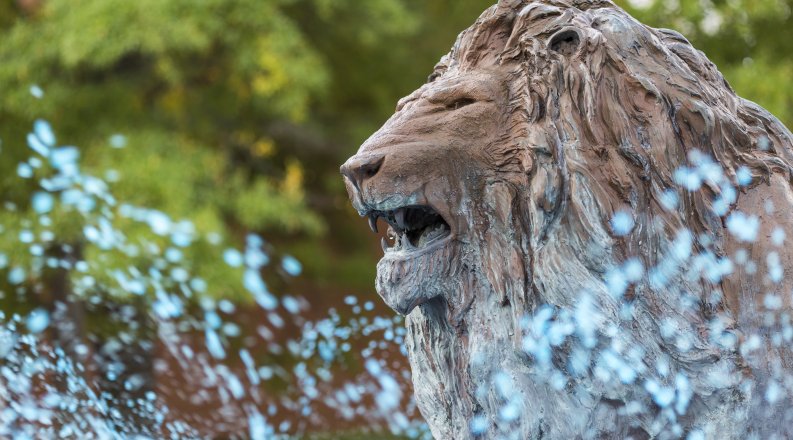The Arthur & Phyllis Kaplan Orchid Conservatory.
By Lorraine Eaton ’85 (M.F.A. ’99)
Before that day when the fever set in, young Darrin Duling loved playing in the woods, climbing trees, "being Tarzan, that type of stuff."
Then, when he was 10, Duling happened upon a sight on the western bank of the Chesapeake Bay that forever changed him: a grove of lady slipper orchids, an entire acre of delicate pink blooms with a few white mixed in.
"It was just amazing," Duling says. "I kept thinking, No one planted these here. This is natural. This is nature."
That's when Duling contracted orchid fever.
It is a well-documented condition afflicting legions of orchidophiles around the globe. Symptoms include compulsive collecting of the plants, travel to distant lands for a glimpse of a rare specimen and, in the most extreme cases, a turn toward crime. One type of orchid was rumored to have fetched $10,000 on the black market.
The fever led Duling to Old Dominion University last year, when he became associate director of the Arthur & Phyllis Kaplan Orchid Conservatory, which boasts 1,200 plants.
Visit the misty, tropical conservatory - a soaring secret garden smack in the middle of campus - and you, too, risk contracting at least a mild form of the malady. Tendrils of orchid blooms spill down the walls like pale pink waterfalls. In beds below - amid ferns and a soaring cinnamon tree - chartreuse, tangerine and alabaster blossoms beckon.
No wonder orchid fever afflicts so many and domestic sales soar into the hundreds of millions of dollars each year.
"It's amazing what orchids do to people," Duling, 58, says. "They mimic, trick and deceive pollinators, and I think they are doing it to us, too."
One afternoon, Duling walks into the balmy warmth of the conservatory and points out a cluster of spade-shaped Lady of the Night blooms dangling amid a spray of green spikes. This Brassavola nodosa is pollinated by moths. To attract them, white petals reach out in the darkness. But that's not all. At night, and only at night, the blooms seal the seduction with a fragrance similar to the iconic Chanel No. 5 perfume.
Duling then focuses on a modest cascade of variegated leaves, the foliage of a vannila orchid. Those vanilla beans sold for exorbitant prices in gourmet food shops? They come from orchids.
And look over there! A butterfly orchid, a native of Trinidad, dazzles with its tangerine petals looking very much like the winged beauties. And there! A trill of white, skirt-shaped petals topped with mottled brown and chartreuse spills down the side of a rock, reminding Duling of a flutter of flamenco dancers.
Duling studied horticulture at the venerable Royal Botanic Gardens, Kew in London, which he describes as "a Harry Potter Hogwarts" for plants. There he had access to treasures such as lotus seeds from King Tut's tomb and Charles Darwin's notes from his HMS Beagle expedition.
Later, Duling discovered a tree in Oman then unknown to the botanical world. He named it Ziziphus hajarensis for the mountain range where it grows.
In New York, he was the curator of glass houses at the New York Botanical Garden and established the first in-house orchid show. He worked in Florida with the American Orchid Society and in Houston with the Mercer Arboretum and Botanic Gardens.
At ODU, Duling and other faculty members train biology and botany students in methods of growing and propagating orchids and other tropical plants. One project is protecting and propagating an endangered orchid growing in ODU's Blackwater Ecologic Preserve in western Tidewater and perhaps reintroducing it into the wild.
He's also working to expand the collection, adding rare and notable plants, and not only orchids.
"We want people to come in here and chill out and dream a little bit," Duling says. "If you like it now, you'll love it in a few years."
The Arthur & Phyllis Kaplan Orchid Conservatory is at the center of the campus, behind the Alfriend Chemistry Building. It is free and open Monday through Friday from 10 a.m. to 2 p.m. when the University is open and other times by appointment. Call 757-683-4081 or go to https://www.odu.edu/sci/research/orchid-conservatory.
This is an excerpt of an article about the conservatory in the summer issue of Monarch magazine. To read the full story and other articles in the magazine, go to www.odu.edu/monarchmag.
Related News Stories
Allan Kirk ’83, a Leading Kidney Transplant Surgeon, Feels “Married” to his Patients
His deeply personal approach has served him well in his role as chairman of the surgery department at Duke University Medical Center. (More)
From ODU to Topping the Music Charts
Corey Michael has been a producer for hits around the world. (More)
Alumna Helps Women Who “Can’t See the Light” After Losing a Baby
Michelle Juarez didn’t take a direct path to counseling – or to ODU. (More)






